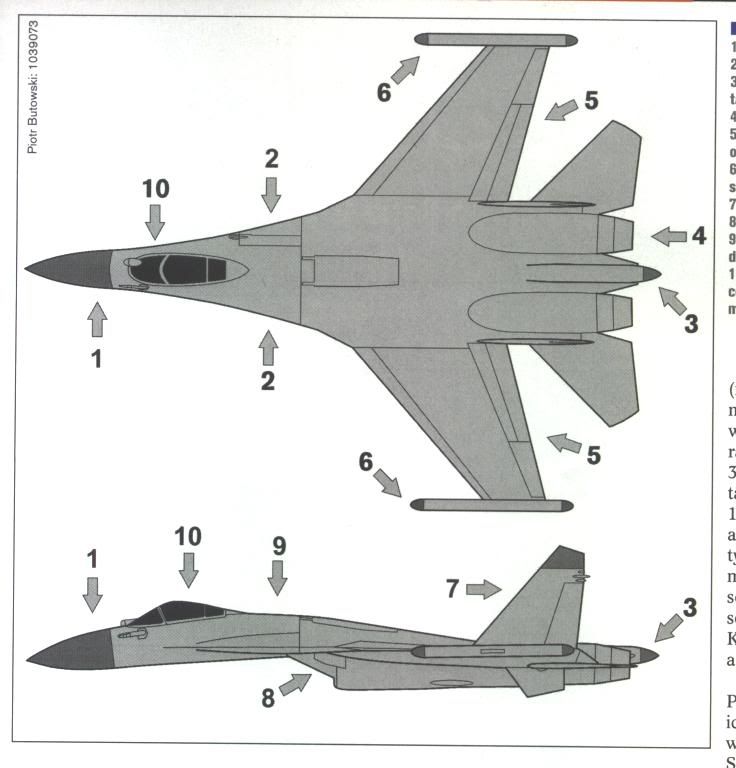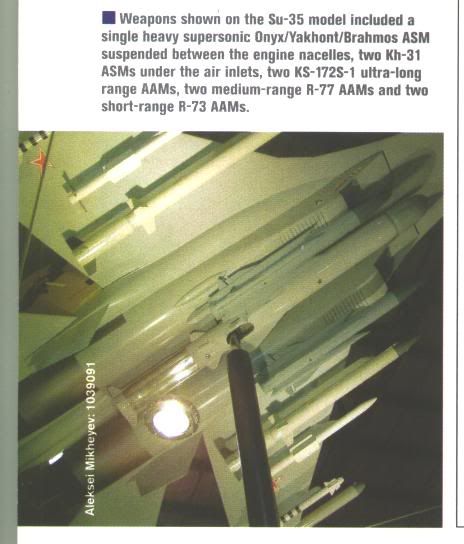3rdMillhouse escreveu:Bolovo escreveu:Carlos, como andas o programa Su-35BM? E os Su-27SK da VVS e etc? Me mantem atualizado aí...

Que programa é esse aí do Su-35BM Bolovo?
Primeiro, para não deixar confuso (se é que dá) o Su-35BM não tem NADA a ver com o Su-35 do FX...
O programa Su-35BM, até onde sei, é a atualização dos Su-27 da Força Aérea Russa a um padrão mais avançado do que os Su-27SK. Esse programa inclui novos motores, diminuição da assinatura radar, novo radar, blá blá blá.
O Carlos sabe explicar melhor.
EDIT: Achei a IMG que explica as modificações...

Photo Credit Janes
New Features Of the Su-35 ( T-10BM Big Modernisation )
1 - N035 Irbis Radar
2 - No canards
3 - Rear-looking self-defence radar in shorter tail sting
4 - AL-41F1A turbofan engines rated at 147kN
5 - Extended high-lift devices with large flaperon occuping the full trailing edge
6 - L175M Khibiny-M electronic-warfare self-defence system
7 - Reduced-area empennage
8 - Larger Air Intakes
9 - New and lighter systems, including quadruple digital fly-by-wire flight-control system.
10- New man-machine interface with fully-glass cockpit with two large LCD screens and helmet mounted display.
The OKB Sukhoi design bureau and the KnAAPO factory are now focusing their attention on a project with the internal designation T-10BM ( Big Modernisation ) and the official designation Su-35 , The one and the only presentation so far of this new edition of the Su-35 was a model that was put on display in December 2003 in Dubai.
The Designation Su-35 has a long history , In 1992 , Sukhoi assigned the designation Su-35 to the export version of the Su-27M ( T-10M) fighter fitted with canards and the N011 radar. Series production of the Su-27M started in Komsomolsk during the last days of the Soviet Union. Five of the 15 manufactured fighters ( including the prototypes ) are presently in service with the 237th Regiment at Kubinka Air Base near Moscow ; several others are used as experimental aircraft. The Su-35 was offered without sucess to several countries including South Korea,UAE and Malaysia and is presently taking part in competition in Brazil. It should be noted that this Su-35 is a new project and not a Su-27M.
The demand for Su-27/Su-30 fighters as they are manufactured currently bu KnAAPO has been nearly fulfilled and it is still a long way to Russias new-generation fighter the PAK-FA. On 26 April 2002 , a government committe chose Sukhoi's T-50 offer in the contest for the 5th gen fighter PAK-FA fighter , On 10 December 2004 Sukhoi submitted the T-50 pilot project for approval by the airforce.
Statements made then say that the prototype T-50 will fly near the end of 2007 and its series production will commence in Komsomolsk around 2012-15.
The Su-35 ( T-10BM) should fill the interim period. Therefore 2007 has been declared by the Sukhoi design bureau as the year when the work on the Su-35 is to be completed , Another objective of the Su-35 programme is to gradually test and implement solutions under development for the T-50. The "transitional" fighter Su-35 is being realised by the same co-operating parties that take part in the T-50 programme. The absence of subsystems and components imported from beyond Russia in the Su-35 project is regarded as being a great advantage for the Russian Air Force as well as for some foreign customers , such as China.
The Russian aerospace community takes delight in subdividing fighter aircraft aircraft into generations .
According to their Classification , the Su-27 is a fourth-generation fighter , the Su-30 MKI/MKK belong to the 4+ (four plus ) generation , The new Su-35 (T-10BM) will belong to generation 4++ and the future PAK FA (T-50) will be a fifth generation fighter. There is also a 5- ( five minus ) generation which includes the early series of the PAK-FA ( T-50 airframe with temporary equipment from the Su-35 )

Photo Credit Janes
The external appearence of the new Su-35 ( T-10BM) is more similar to the Su-27 than to the former Su-35 ( T-10M):
1 ) It has no canards
2 ) The fins are smaller than before and the sting protruding rearwards between the engines is shorter.
3 ) The high-lift devices have been changed and are similar to those applied to the Su-33 shipborne fighter with big flaperons occupying the whole trailing edge of the wing.
4 ) The Su-35 will be powered by two of the new AL-41 F1A turbofans , providing 142 to 147 kN of thrust each.The AL-41F1A engine is as "transitional" as the whole Su-35 aircraft. The final production engine for the PAK-FA (T-50 ) will be the AL-41 F1 fitted - when compared with the present A version - with a new core.
In July 2003, all the leading Russian air engine manufacturers signed an aggrement to work together on this.
The Tikhomirov NIIP institute in Zhukovsky is now designing for the Su-35 the
new N035 Irbis radar with passive electronic scanning . When compared to BARS the Irbis radars antenna is suspended on a quick-fastened console rotating in azimuth by 50 to 60*(degree) to each side ( therefore securing a field of regard of more than 200* ) ; the console is additionally rotated in roll.
The Su-35 has also a small radar installed inside the sting between the engines and looking aft. Such an idea has been developing in Russia since mid-1980: rear-looking radars were installed on several prototypes of the 'old' Su-27M/Su-35 ( N012 radar designed by NIIR Rassvet) , to the Mig-1.42 ( Rassvet N015) and to the Su-27IB ( V005 radar by Leninets ) . At the same time , tests were made of the air to air missiles launched rearwards. The interest in this concept declined and only came back in early 2000s. The Tikhomirov NIIP institute suggests for this purpose its passive phased array radar Osa and is expected to announce a new active phased-array radar of this class within the next few months.
The model of the Su-35 (BM) shown in Dubai in December 2003 carried an interesting armament . A large supersonic anti-ship missile of the Onyx/Yakhont/Brahmos family ( depending on the customers requirement , each of the missiles variants may be used ) was carried between the engines.
Under the wings were two ultra-long range KS-172S-1 air to air missiles developed by the Novator Company of Yekaterinburg. This was the first presentation of this missile after 10 years of silence ( in August 1993 , in Zhukovsky a full-size mockup of the KS-172 missile was shown with the Su-30 fighter ).
The maximum range of the KS-172, stated by Novator is 300 km. The missile is to be used against targets flying at any altitude betwenn 10 - 100000 ft with speeds of up to 4000 km/h and with g-loads up to 12 , including all types of aircraft , as well as long and medium range anti-aircraft missile ( in self defense ). The remaining weapons seen on the Su-35 model were standard Kh-31 air to surface missiles and R-77 and R-73 air to air missiles.
An announcement by the Ramenskoye PKB Company, the manufacturer of avionics for both PAK-FA and Su-35 , said there will not be any analogue instruments in the Su-35 cockpit. In front of the pilot there will be only two liquid crystal displays ; additionally the essential information will be repeted on the pilots helmet screen
*** FAIR USE NOTICE. This message contains copyrighted material whose use has not been specifically authorized by the copyright owner. It is being made available without profit to those who have expressed a prior interest in receiving the included information in their efforts to advance their understanding of arms trade activities, for non-profit research and educational purposes only. I believe that this constitutes a 'fair use' of the copyrighted material as provided for in section 107 of the U.S. Copyright Law. If you wish to use this copyrighted material for purposes of your own that go beyond 'fair use,' you must obtain permission from the copyright owner.
For more information go to:
http://www.law.cornell.edu/uscode/17/107.shtml




, mais tem q ser em boa quantidade.






